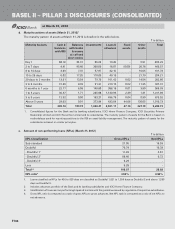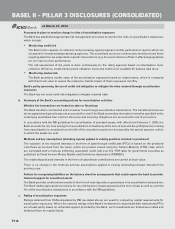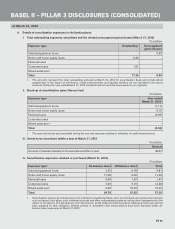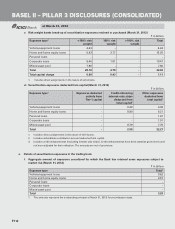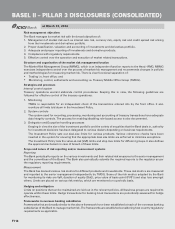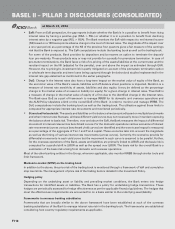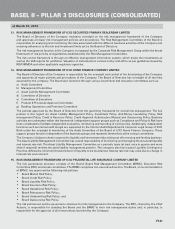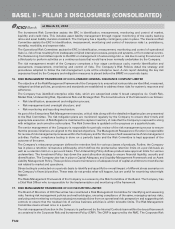ICICI Bank 2012 Annual Report Download - page 192
Download and view the complete annual report
Please find page 192 of the 2012 ICICI Bank annual report below. You can navigate through the pages in the report by either clicking on the pages listed below, or by using the keyword search tool below to find specific information within the annual report.
F114
Risk management objectives
The Bank manages its market risk with the broad objectives of:
1. Management of market risk such as interest rate risk, currency risk, equity risk and credit spread risk arising
from the investments and derivatives portfolio.
2. Proper classification, valuation and accounting of investments and derivatives portfolio.
3. Adequate and proper reporting of investments and derivative products.
4. Compliance with regulatory requirements.
5. Effective control over the operation and execution of market related transactions.
Structure and organisation of the market risk management function
The Market Risk Management Group (MRMG), which is an independent function reports to the Head - RMG. MRMG
exercises independent control over the process of market risk management and recommends changes in policies
and methodologies for measuring market risk. There is clear functional separation of:
Trading i.e. front office; and
Monitoring, control, settlements and accounting i.e. Treasury Middle Office Group (TMOG).
Strategies and processes
Internal control system
Treasury operations warrant elaborate control procedures. Keeping this in view, the following guidelines are
followed for effective control of the treasury operations:
1. Monitoring
TMOG is responsible for an independent check of the transactions entered into by the front office. It also
monitors all limits laid down in the Investment Policy.
2. System controls
The system used for recording, processing, monitoring and accounting of treasury transactions have adequate
data integrity controls. The process for enabling/disabling role-based access is also documented.
3. Delegation and Exception handling processes
Keeping in view the size of the investment portfolio and the variety of securities that the Bank deals in, authority
for investment decisions has been delegated to various dealers depending on business requirements.
The Investment Policy sets out deal-size limits for various products. Various coherence checks have been
inserted in the system for ensuring that the appropriate deal size limits are enforced to minimise exceptions.
The Investment Policy lists the value-at-risk (VaR) limits and stop loss limits for different groups. It also defines
the approval mechanism in case of breach of these limits.
Scope and nature of risk reporting and/or measurement systems
Reporting
The Bank periodically reports on the various investments and their related risk measures to the senior management
and the committees of the Board. The Bank also periodically submits the required reports to the regulator as per
the regulatory reporting requirements.
Measurement
The Bank has devised various risk metrics for different products and investments. These risk metrics are measured
and reported to the senior management independently by TMOG. Some of the risk metrics adopted by the Bank
for monitoring its risks are VaR, duration of equity (DoE), price value of basis point (PV01) and stop loss amongst
others. Limits are placed on various risk metrics, which are monitored on a periodic basis.
Hedging and mitigation
Limits on positions that can be maintained are laid out in the relevant policies. All business groups are required to
operate within these limits. Hedge transactions for banking book transactions are periodically assessed for hedge
effectiveness.
Frameworks in overseas banking subsidiaries
Frameworks that are broadly similar to the above framework have been established at each of the overseas banking
subsidiaries of the Bank to manage market risk. The frameworks are established considering host country regulatory
requirements as applicable.
BASEL II – PILLAR 3 DISCLOSURES (CONSOLIDATED)
at March 31, 2012


